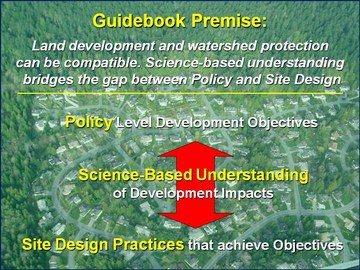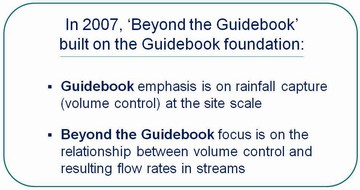Beyond the Guidebook 2010: Moving from Awareness to Action to Achieve Water Sustainability in British Columbia

Land Development and Watershed Protection Can Be Compatible
In 2002, Stormwater Planning: A Guidebook for British Columbia advanced this provocative premise: land development and watershed protection can be compatible. This radical shift in practitioner thinking resulted from recognition of HOW a science-based understanding could bridge the gap between high-level policy objectives and site design practices.
The basis for this premise was that municipalities exert control over runoff volume through their land development and infrastructure policies, bylaws, standards, practices and actions. A key to the breakthrough in thinking and approach was developing the concept of the rainfall spectrum and translating the concept into an integrating strategy.
Towards a Lighter ‘Hydrologic Footprint’
The Guidebook applied a science-based understanding to lighten the hydrologic footprint, developed the water balance methodology to establish performance targets for rainfall capture, and demonstrated that urban watershed restoration could be accomplished over a 50-year timeframe as and when communities redevelop.
The Guidebook was a pioneering application of a watershed/landscape-based approach to community planning. The premise underpinning the landscape-based approach is that resource, land use and community design decisions will be made with an eye towards their potential impacts on stream and watershed health.

Beyond the Guidebook 2007
Over the next five years, British Columbia practitioners became comfortable with what ‘rainfall capture’ meant in practice. By 2007, it was time to focus attention on how to truly protect and/or restore stream health in urban watersheds. The evolution in watershed thinking was captured in Beyond the Guidebook: Context for Rainwater Management and Green Infrastructure in British Columbia, released in June 2007.
Beyond the Guidebook 2007 initiated the paradigm-shift from the single-function view of traditional ‘stormwater management’ to the integrated and holistic perspective that is captured by the term ‘RAINwater Management’.
Beyond the Guidebook 2007 foreshadowed Living Water Smart, British Columbia’s Water Plan and the Green Communities Initiative, both of which were launched by the Province in 2008. These established an over-arching provincial ‘design with nature’ policy framework. There is now clear guidance for aligning local actions with provincial and regional goals to achieve water sustainability.

Beyond the Guidebook 2010
Now, ‘Beyond the Guidebook 2010’ connects the dots between RAINwater Management and Drought Management and shows how to achieve water sustainability through outcome-oriented urban watershed plans.
Released in June, Beyond the Guidebook 2010: Implementing a New Culture for Urban Watershed Protection and Restoration in British Columbia describes how a ‘convening for action’ philosophy has taken root in British Columbia .
 “Bringing together local government practitioners in neutral forums has enabled implementers to collaborate as regional teams. Their action-oriented focus has resulted in ‘how to do it’ examples that help decision-makers visualize what ‘design with nature’ policy goals look like on the ground,” reports Kim Stephens, editor of Beyond the Guidebook 2010.
“Bringing together local government practitioners in neutral forums has enabled implementers to collaborate as regional teams. Their action-oriented focus has resulted in ‘how to do it’ examples that help decision-makers visualize what ‘design with nature’ policy goals look like on the ground,” reports Kim Stephens, editor of Beyond the Guidebook 2010.
How Change is Being Implemented
People learn through stories. Beyond the Guidebook 2010 is the ‘telling of the stories’ of how change is being implemented on the ground in British Columbia. These stories demonstrate that the practitioner and community culture is changing as an outcome of collaboration, partnerships alignment.
Case study experience presented in Beyond the Guidebook 2010 clearly shows that a new land ethic is taking root in British Columbia. Changing the culture requires a process. This takes time to complete. There is no short-cut; however, lessons learned by those who have done it can help those who want to move to a design with nature strategy.
Building on case study experience, Beyond the Guidebook 2010 provides local governments with ‘how to’ guidance for developing outcome-oriented urban watershed plans. It describes web-based tools that British Columbia has developed to support new approaches to water management.
To Learn More:
To download a copy, click on Beyond the Guidebook 2010: Implementing a New Culture for Urban Watershed Protection and Restoration in British Columbia.


